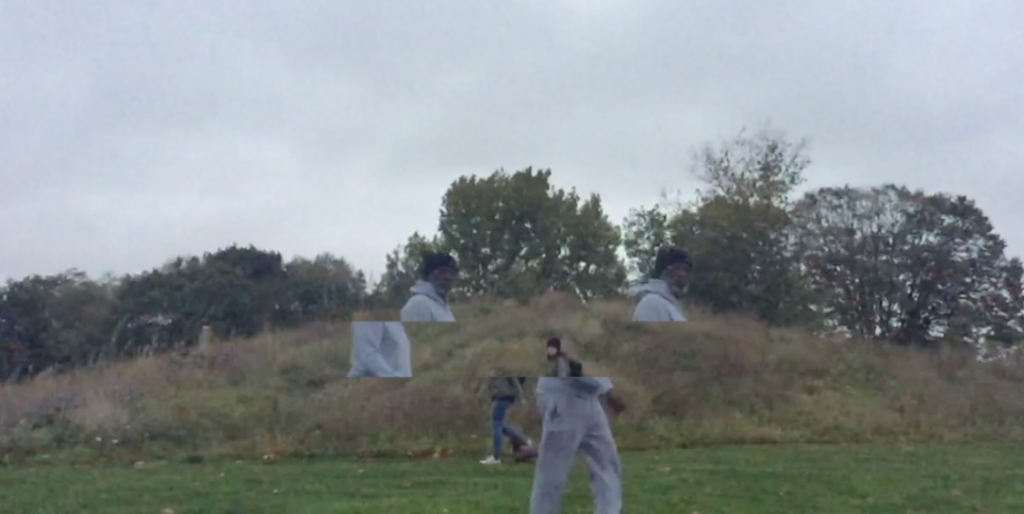A couple of months after having initially heard about it, I recently downloaded open-source 3D rendering programme ‘Blender’, and have since been trying to teach myself how to use it to make simple figurative animations as well as create fake landscapes, with the ultimate intention to combine the two and ‘paint’ fake happenings in made up landscapes.
I’m wary of delving too far into the internet/vaporwave ‘aesthetic’ that seems to have already reached cliché territory within contemporary art and mainstream youth culture, but using the programme has been interesting in regards to how I’m trying to think of information and object. What I am looking at when working on the platform is always just a group of RGB pixels; a single, flat layer of information that allows me to experience the illusion of form by constantly shifting when I use my mouse to command an orientation around the ‘object’ I’m working on. This makes the image feel like a sculpture but unlike seeing a sculpture from a single point of view in real life, there is nothing behind it at that point, which significantly broadens the potential of what the object could become visually when rotated, a simulation of walking around it with your body. It brings to mind the Minimalists’ (specifically, Rudolf Arnheim and George Kubler) idea of The Good Gestalt, the relationship between body and world and how one should be able to correctly predict what a sculptural object will look like from the other side, an answer to creating form from chaos. For example, when viewing a cube from one central vertex and only being able to see three faces, we can predict that the cube is actually made of 6 faces, the other three of which would be visible if we stepped around it to view the other side. You sense more than you can see: there’s nothing to discover. TIn turn, a sensation of meaning is produced: The Good Gestalt. This was later fought against by Anton Ehreschweig, who was then followed by Robert Smithson and Robert Morris, and so on.
Whilst thinking about this, I rendered a few variations of the same scene, whereby two wrestlers, frozen mid-pose, are covered by a falling sheet that encloses them before falling to a resting position.
The process of digital rendering offers an exciting opportunity to debunk this Gestalt idea further, as rendered ‘objects’ do not have to comply with any kind of time or force based physics, which gives much potential to create something that can trick peoples’ initial assumptions of what’s on the other side.




This is the one of the few instances where my distrust for what I can’t see actually rings true. Once the sheet covers the figures, they are lost until I tell them to reappear by deleting the sheet. The way we see digital space is the same as how we interpret physical space but the two are not the same, and this is amplified when rendered as a single image. Even the way social media apps are designed feeds into this imaginary 3D space that we envision when experiencing them. Menus seem to be set adjacent to each other, and you can translate yourself from one to the other with a swiping motion, implying that there’s an invisible space to the right or left of the visible screen in your hand, waiting to be revealed. This of course is not true, but it’s easy to envision otherwise.
The writings of Merleau-Ponty on our bodily, grasp-based understanding of natural and physical objects, and the consequent questioning of this in relation to technology in Paul Virilio’s Vision Machine come to mind here, and these are definitely writings that I want to explore further in relation to my own digital practices.
When you commit to a final render in Blender, anything outside of the confines of the camera box, which is moveable and represented by a pyramid with an X interrupting the base, becomes unrecoverable data, existing only as the memory of the original creator. The pixels are not simply ‘frozen’ in the past, as the areas outside the periphery of a real camera lens are, but are lost completely. The contents of the lens is suddenly alone in the middle of a void. This is not the same as taking a photo of a place before leaving it, as that place still exists whether you’re there or not, just not as it was in the photograph. The artist Ed Ruscha featured in Joachim Koester’s book ‘Of Spirits and Empty Spaces'(in unknowing collaboration with Koester) did undertake a series looking at this in 1970, where he documented a number of empty lots under the titel Real Estate Opportunities. Koester then photographed some of those exact locations – spaced that by that point had sold, built up and been transformed. When looking at digital landscapes, this progression does not naturally happen, but what would it look like if it was programmed to age?
This led me to look at constructing made up landscapes that aren’t based in any kind of timeframe or reminiscent of any particular location. They exist only as the result of a number of mathmatical formulas, just as landscape paintings exist only as ‘mud on a surface’ (to quote Andrew Stahl’s apparent favourite phrase ever). These landscapes are made for the camera, with the grasses and weeds sprouting from the surface ceasing as soon as the camera lens’ periphery is reached, as displayed below.



